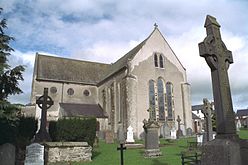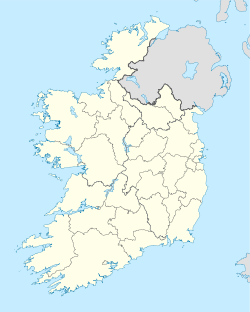- Duiske Abbey
-
Duiske Abbey Mainistir an Dubhuisce 
Choir window from South EastAlternative names Graiguenamanagh Abbey General information Type monastery, abbey, church Architectural style English Gothic, gothic, romanesque Address Abbey Street Town or city Graiguenamanagh Country Ireland Coordinates 52°32′28.15″N 6°57′16.79″W / 52.5411528°N 6.9546639°WCoordinates: 52°32′28.15″N 6°57′16.79″W / 52.5411528°N 6.9546639°W Construction started 1202-4 Inaugurated 1207 Renovated 1970-1980 Reference #: 620 Duiske Abbey National Monument, also known as Graiguenamanagh Abbey, is a 13th century Cistercian monastery situated in Graiguenamanagh, County Kilkenny in Ireland.[1][2]
Duiske Abbey was founded by William Marshall in 1204 and is one of the first, largest and perhaps the finest of the thirty-four medieval Cistercian monasteries in Ireland. The Abbey is the parish church of Graiguenamanagh town and beautifully dominates the town centre.
The Abbey is located in the valley of the river Barrow, on a site between the main river and the Duiske tributary. The abbey derives its name from the Douskey River Irish: An Dubhuisce, meaning "Black Water".[3]
Contents
History
The Abbey was founded in 1204 by William Marshall the elder, earl of Pembroke, and was colonized with monks from Stanley in Wiltshire. The monks may not have arrived at Graiguenamangh until 1207, but it seems that building may have begun in 1204 when the cemetery at Duiske was consecrated.
In 1228 the religious community was fixed at thirty-six monks and fifty lay-brothers which was almost as large as Mellifont Abbey. The abbot of Duiske sat as a peer in parliament at that time.
The Abbey was suppressed under Henry VIII in 1536 and the last abbot, Charles O’Cavanagh, resigned his title. Monks continued to occupy it but it began to fall into ruin. Following the dissolution the lands were awarded to James Butler of Duiske. The abbey church continued to be used as a local place of worship. The Church of Ireland re-roofed the west end after the tower collapsed into the nave in 1744. The church was returned to the Roman Catholic community in 1812 and restoration was completed in the 1980s. Currently it is used as a parish church and music events are held there.[4]
Building
Duiske Abbey was one of the first, largest and perhaps the finest of the thirty-four medieval Cistercian monasteries in Ireland. Much of the abbey was constructed with yellow limestone brought across the Irish Sea from quarries at Dundry, outside Bristol.
Significant remains of the monastery still exist and the remains are fully restored as an early Cistercian Church. Original medieval floor tiles from the original building can be seen in the abbey along with the beautiful "Early English" gothic and romanesque architecture. Some of the 13th-century stonework can still be seen, including still-leaf foliage carved into the capitals, dog-tooth ornaments and banded shafts. It contains many Lancet windows.
An effigy of a 13th century Norman Knight found in the ruins is installed by the main entrance. He is depicted seizing a sword and is carved with great attention to detail. It is one of the finest medieval effigies in Ireland. In its northern aisle a model of the monastery shows the abbey as it was in the 14th century. Explanation plaques are at various points in the Abbey. In the nearby Abbey Centre there is an exhibition of contemporary Christian Art and local historic artefacts.
See also
- Graiguenamanagh
- List of abbeys and priories in Ireland (County Kilkenny)
- List of National Monuments in County Kilkenny
Notes
- ^ "Cistercian Abbeys: Duiske (Graiguenamanagh)", cistercians.shef.ac.uk, http://cistercians.shef.ac.uk/abbeys/graiguenamanagh.php
- ^ (Bradley 1981).
- ^ "Douskey River (river)". logainm.ie. http://www.logainm.ie/116254.aspx. Retrieved 26 October 2010.
- ^ "Duiske Concerts", duiskeconcerts.ie, http://www.duiskeconcerts.ie/
References
- Bradley, J. (1981), Excavations at Duiske Abbey, Graiguenamanagh Co. Kilkenny, Proceedings of the Royal Irish Academy., Vol. 81C, C. Manning, D. Newman Johnson (Section C: Archaeology, Celtic Studies, History, Linguistics, Literature. ed.), Royal Irish Academy, pp. 397–405, 407–426, JSTOR 25506077.
Further reading
- Butler, C.M. (1918), The charters of the Cistercian Abbey of Duiske in the county of Kilkenny, Proceedings of the Royal Irish Academy, v. 35, section C, no 1, Dublin: Hodges, Figgis, OCLC 37628652.
- Carville, Geraldine (1979), Norman Splendour: Duiske Abbey, Graignamanagh, Belfast: Blackstaff Press, ISBN 978-0856401718.
- Carville, Geraldine (1980), A Town Remembers Duiske Abbey, Graignamanagh: an Illustrated History and Guide.
- O'Leary, Patrick (1924), Graiguenamanagh Abbey.
- O'Leary, Patrick (1892), Notes on the Cistercian Abbey of Graiguenamanagh, Proceedings of the Royal Irish Academy.
- Swayne, Séan (1988), Duiske Abbey, Graignamanagh, Criterion Press.
- Walsh, Kilian (1972), Graiguenamanagh Abbey.
External links
- "The Cistercians in Yorkshire", cistercians.shef.ac.uk, http://cistercians.shef.ac.uk/abbeys/graiguenamanagh.php
- "Duiske Abbey", discoverireland.ie, http://www.discoverireland.ie/Search-Results/Details.aspx?touristItemID=11170
Categories:- Cistercian monasteries in the Republic of Ireland
- Buildings and structures in County Kilkenny
- Religion in County Kilkenny
- 13th-century architecture
- Ruins in the Republic of Ireland
- Religious organizations established in the 1200s
- Christian monasteries established in the 13th century
- National Monuments in County Kilkenny
Wikimedia Foundation. 2010.


